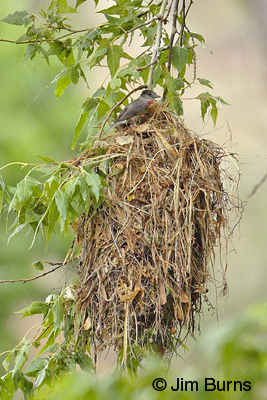
Patagonia is a tiny ranching community, with an overlay of artists, on Highway 82 southeast of Tucson. It lies in a valley, cool in summer, cold in winter, along Sonoita Creek between the Canelo Hills and the Santa Rita Mountains. Four miles south of town is a roadside rest with one picnic table (no overnight camping or parking). In 1971 birders lunching there discovered the first black-capped gnatcatcher ever recorded north of the border, and the influx of birders searching for the gnatcatcher then found the first North American record yellow grosbeak. Thus was born the Patagonia Picnic Table Effect--one good bird brings more birders who find yet another good bird which brings even more birders, etc., a scenario played out several times a year somewhere in the birding world.
The famous roadside rest and the 150 yard trail along the creek across the highway (do not get killed crossing the highway and do not trespass over the fence or birders will kill you anyway) is summer home to thick-billed kingbirds (reliable), Arizona's noisiest birds, and rose-throated becards (occasional), builders of a spectacular hanging nest shaped like a huge football.
The rest area lies at the heart of the scenic Sonoita-Nogales corridor which is the entre to three other "must do" birding venues which host a variety of much sought birdlife during breeding season. The first, on a dirt road south of Patagonia, is the Nature Conservancy's Patagonia-Sonoita Creek Preserve (Wednesday-Sunday, 6:30 a.m. to 4:00 p.m., April to September, $5/person) where you're sure to see vermilion flycatchers, yellow-billed cuckoos, and bridled titmice. At the north end of this road is Marion Paton's renowned backyard (open to the public) with its feeders, always a reliable place to see the beautiful violet-crowned hummingbird.
Three miles south of the rest area is Patagonia Lake State Park, a variety of sparrows along its entrance road, cormorants and ducks on the water, and wrens, gnatcatchers, and warblers nesting in the mesquite bosques at the east end of the lake. Seven miles south of the park you'll find Kino Springs, a housing/golf development with three small ponds surrounded by old cottonwoods. Look for gray hawks, varied buntings, and tropical kingbirds. Be sure to pull off the road and do not interfere with the golfers. These areas are detailed in Richard Taylor's A Birder's Guide to Southeastern Arizona.
The Santa Cruz River flowing north out of Mexico across our state's southern border forms, with its tributary Sonoita Creek, a literal highway of green for southern Arizona's plethora of special bird species, themselves a river of life flowing north each spring to renew the riparian corridors with color and song. Go now. The location is good, the weather perfect. Maybe you'll find another rarity and become part of the Patagonia roadside rest legend.